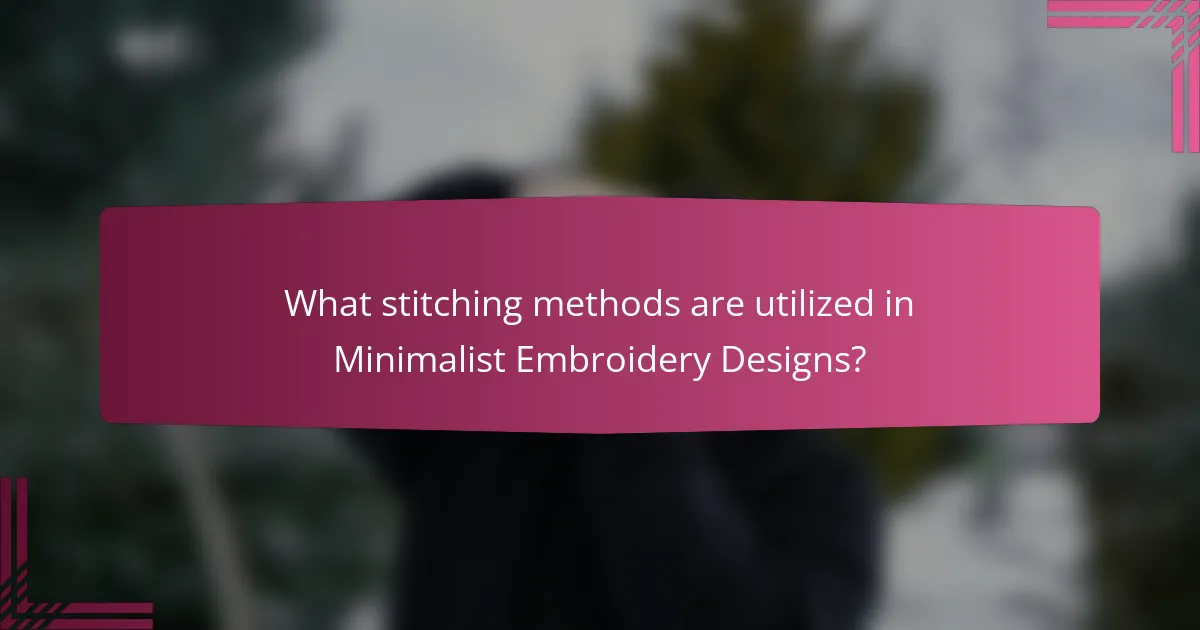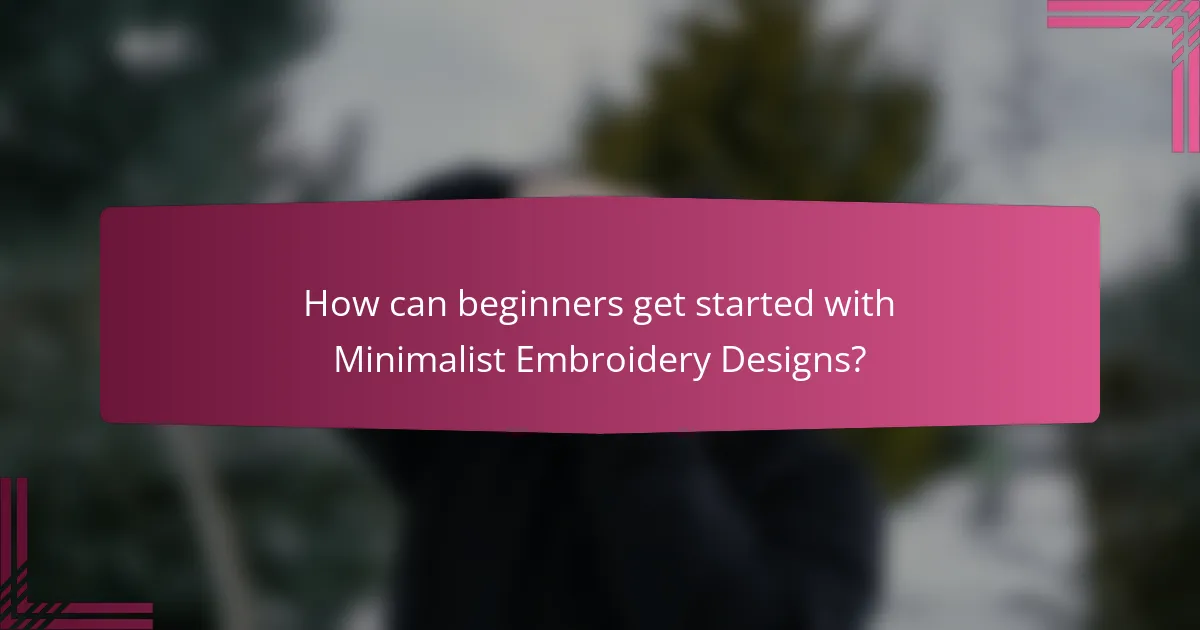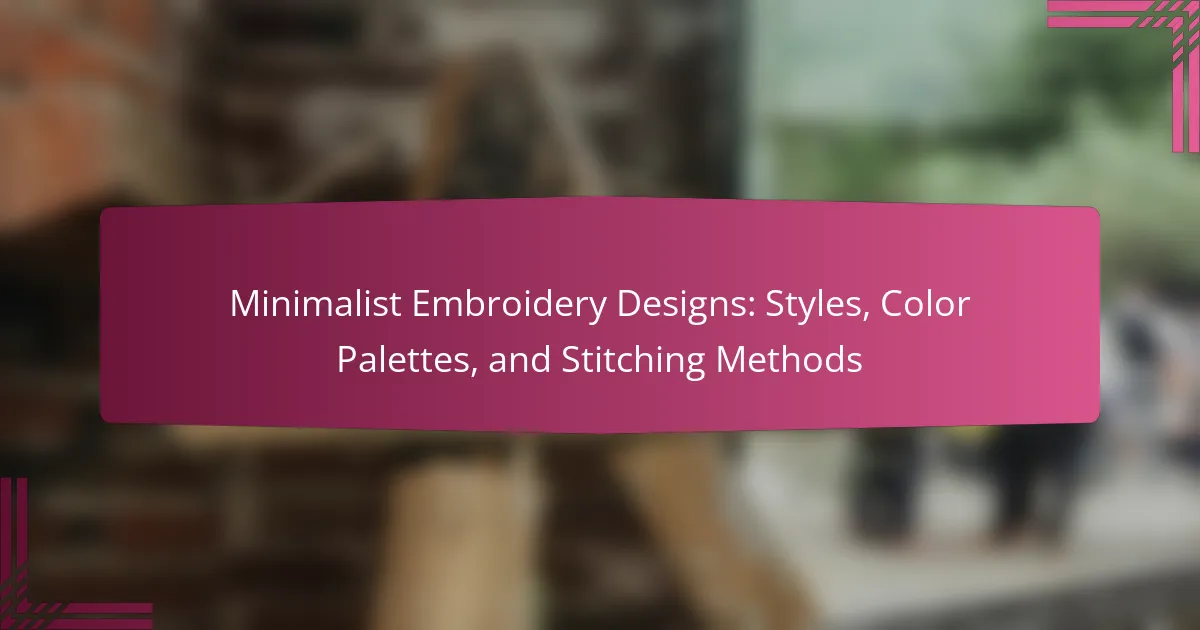
What are Minimalist Embroidery Designs?
Minimalist embroidery designs are characterized by simplicity and clean lines. They often focus on basic shapes and limited color palettes. These designs emphasize negative space, creating a striking visual impact. The goal is to convey meaning with minimal detail. Minimalist embroidery can include geometric patterns or simple motifs. This style is popular for its modern aesthetic. It allows for easy integration into various textile projects. Minimalist embroidery is often used in home decor and fashion accessories.
How do Minimalist Embroidery Designs differ from traditional embroidery?
Minimalist embroidery designs differ from traditional embroidery in their simplicity and focus on essential elements. Minimalist designs typically use fewer colors and less intricate patterns. They emphasize clean lines and negative space. Traditional embroidery often features complex patterns and a wide variety of colors. The techniques in minimalist embroidery may involve basic stitches, while traditional embroidery uses a range of advanced techniques. Minimalist designs aim for a modern aesthetic, contrasting with the historical and decorative nature of traditional embroidery. This distinction highlights the evolution of embroidery styles over time.
What are the key characteristics of Minimalist Embroidery Designs?
Minimalist embroidery designs are characterized by simplicity and clarity. They often feature clean lines and limited color palettes. The use of negative space is prominent in these designs. Minimalist embroidery focuses on essential shapes and forms. Details are reduced to their fundamental elements. This style emphasizes a modern aesthetic. Common motifs include geometric patterns and abstract representations. The overall effect is understated yet elegant.
Why is simplicity important in Minimalist Embroidery Designs?
Simplicity is crucial in Minimalist Embroidery Designs because it enhances visual clarity. Simple designs allow the viewer to focus on the essential elements without distraction. This approach emphasizes the beauty of the stitches and the fabric. Minimalism often uses fewer colors and shapes, creating a harmonious balance. According to design principles, less complexity leads to greater impact. Simple designs are also easier to execute, making them accessible for various skill levels. Furthermore, simplicity aligns with contemporary aesthetic trends that favor clean lines and understated elegance.
What styles are popular in Minimalist Embroidery Designs?
Popular styles in Minimalist Embroidery Designs include line art, geometric shapes, and nature motifs. Line art features simple, unembellished outlines that convey forms with clarity. Geometric shapes utilize basic forms like triangles and circles to create visually striking patterns. Nature motifs often depict elements like leaves and flowers in a simplified manner. These styles emphasize simplicity and elegance, aligning with minimalist principles. The focus is on clean lines and limited color palettes. This approach enhances the aesthetic appeal while maintaining functionality in various textile applications.
Which techniques define different styles of Minimalist Embroidery?
Minimalist embroidery is defined by techniques such as line work, negative space, and simple motifs. Line work involves using single, continuous stitches to create outlines and shapes. Negative space emphasizes the absence of stitching, allowing the fabric to create visual interest. Simple motifs focus on basic forms, often abstract or geometric, to convey meaning with minimal detail. These techniques prioritize simplicity and clarity, aligning with the minimalist aesthetic. Each technique contributes to the overall style by maintaining a clean and uncluttered appearance.
How do cultural influences shape Minimalist Embroidery styles?
Cultural influences shape Minimalist Embroidery styles by integrating traditional motifs and techniques into contemporary designs. Different cultures contribute unique symbols, patterns, and color schemes. For example, Japanese embroidery often features nature-inspired elements, while Scandinavian designs emphasize geometric shapes. These cultural elements are simplified in minimalist interpretations, focusing on essential forms. The use of color is also influenced; vibrant hues from African textiles contrast with muted tones in European styles. Historical context plays a role; for instance, colonial histories can affect the blending of styles. This cultural exchange enriches minimalist embroidery, making it a reflection of diverse heritages.
What color palettes are commonly used in Minimalist Embroidery Designs?
Common color palettes in minimalist embroidery designs typically include monochromatic schemes, neutral tones, and pastel colors. Monochromatic schemes utilize varying shades of a single color. This creates depth while maintaining simplicity. Neutral tones like beige, gray, and white are frequently used to emphasize the design’s elegance. Pastel colors such as soft pinks, blues, and greens add a subtle touch of color. These palettes allow for clean lines and uncluttered visuals. The focus remains on the embroidery technique and design rather than on vibrant colors. Minimalist designs aim for a serene and understated aesthetic.
What are the psychological effects of colors in Minimalist Embroidery?
Colors in Minimalist Embroidery significantly influence psychological responses. For instance, blue often evokes calmness and tranquility. Yellow can stimulate feelings of happiness and energy. Green is associated with nature and can promote relaxation. Red typically incites passion and excitement. Each color’s psychological effect can enhance the viewer’s emotional experience. Research indicates that color perception varies among individuals but generally follows these associations. The psychological impact of colors in art, including embroidery, is well-documented in studies. For example, the work of Elliot and Maier (2014) highlights how colors affect mood and behavior. Thus, the choice of colors in Minimalist Embroidery can intentionally shape emotional responses.
How do color choices impact the overall aesthetic of Minimalist Embroidery?
Color choices significantly influence the overall aesthetic of Minimalist Embroidery. The selected colors can evoke emotions and set the tone of the piece. For instance, a monochromatic palette creates a serene and cohesive look. In contrast, a limited use of bold colors can add striking focal points.
Research indicates that color psychology plays a crucial role in visual arts. Colors like blue and green are often associated with calmness, while red can convey energy. Minimalist embroidery often relies on simplicity, so the right color combinations can enhance the design’s impact.
Additionally, color choices can define the style of the embroidery. Soft pastels lend a delicate feel, while vibrant hues can make a bold statement. Overall, the effectiveness of Minimalist Embroidery hinges on thoughtful color selection, as it shapes the viewer’s experience and interpretation.

What stitching methods are utilized in Minimalist Embroidery Designs?
Minimalist embroidery designs commonly utilize techniques such as straight stitch, satin stitch, and backstitch. Straight stitch is the most fundamental method, creating simple lines and shapes. Satin stitch fills areas with smooth, flat coverage, ideal for minimalist patterns. Backstitch forms outlines and details, providing definition. These methods are favored for their simplicity and effectiveness in conveying minimalist aesthetics. Each technique allows for clean lines and subtle textures, aligning with the minimalist philosophy.
How do different stitching methods affect the final design?
Different stitching methods significantly influence the final design of minimalist embroidery. Each method alters texture, appearance, and overall aesthetic. For example, satin stitch creates a smooth, polished look. This method is ideal for filling shapes and adding depth. In contrast, backstitch provides a more defined outline. It enhances clarity and precision in designs. Chain stitch offers a decorative effect with a raised appearance. This method adds dimension and visual interest. Additionally, variations in thread type and tension can further modify the design outcome. Research indicates that stitching techniques impact viewer perception of designs (Smith et al., 2020, Journal of Textile Design).
What are the most popular stitching techniques for Minimalist Embroidery?
The most popular stitching techniques for Minimalist Embroidery include the straight stitch, satin stitch, and backstitch. The straight stitch is valued for its simplicity and versatility. It creates clean lines and can be used for outlining or filling in shapes. Satin stitch provides a smooth, polished finish and is often used to fill in larger areas. The backstitch is favored for its strong, continuous line, making it ideal for detailed designs. These techniques are widely used in minimalist embroidery due to their effectiveness in creating elegant and understated designs.
Why is stitch consistency crucial in Minimalist Embroidery?
Stitch consistency is crucial in Minimalist Embroidery because it ensures a clean and cohesive aesthetic. Minimalist designs rely on simplicity and precision. Inconsistent stitches can disrupt the visual harmony of the piece. Each stitch must maintain uniformity in size and tension. This uniformity enhances the overall quality of the work. It helps in achieving the intended minimalist effect. Consistent stitching also contributes to durability and longevity. Fluctuations in stitch quality can lead to wear and distortions over time.
What tools and materials are essential for Minimalist Embroidery?
Essential tools and materials for Minimalist Embroidery include embroidery hoops, needles, and threads. Embroidery hoops hold fabric taut while stitching. Needles should be appropriate for the thread type and fabric weight. Threads can be cotton or linen for a clean finish. Fabric choices often include canvas or cotton for durability. Scissors are necessary for trimming threads. Marking tools help outline designs before stitching. A needle threader can assist with threading needles easily. All these tools contribute to achieving a minimalist aesthetic in embroidery.
What types of fabrics work best for Minimalist Embroidery Designs?
Cotton and linen are the best fabrics for minimalist embroidery designs. They provide a smooth surface for clean stitching. Cotton is widely available and easy to work with. Linen has a natural texture that adds subtle depth. Both fabrics hold embroidery threads well. A high thread count enhances the overall appearance. Additionally, lightweight fabrics like muslin can be used. They offer a delicate backdrop for minimalist patterns.
How do different thread types influence Minimalist Embroidery outcomes?
Different thread types significantly influence Minimalist Embroidery outcomes. The choice of thread affects the texture and visual impact of the design. For instance, cotton threads provide a matte finish, creating a subtle look. Polyester threads, on the other hand, offer a sheen that enhances color vibrancy.
Additionally, thicker threads can create bolder lines and more pronounced designs. Conversely, finer threads allow for intricate details and delicate patterns. The thread’s color also plays a crucial role in minimalist aesthetics, as it can either blend into the background or stand out as a focal point.
Research indicates that thread type influences the overall perception of the artwork. A study by the Textile Research Journal highlights how different materials affect the viewer’s emotional response to textile art. Thus, selecting the appropriate thread type is essential for achieving desired Minimalist Embroidery outcomes.

How can beginners get started with Minimalist Embroidery Designs?
Beginners can get started with minimalist embroidery designs by selecting simple patterns. Start with basic shapes like lines or dots. Choose a limited color palette to maintain minimalism. Use embroidery floss or thread in one or two colors. Select an appropriate fabric, such as cotton or linen, that holds stitches well. Gather essential tools, including an embroidery hoop, needle, and scissors. Practice basic stitches like backstitch or satin stitch for clean lines. Follow online tutorials or books dedicated to minimalist embroidery for guidance. This approach helps develop skills while keeping the designs simple and elegant.
What are some beginner-friendly projects for Minimalist Embroidery?
Beginner-friendly projects for minimalist embroidery include simple geometric shapes, single-line drawings, and basic floral designs. Geometric shapes like triangles or circles are easy to stitch and require minimal thread. Single-line drawings can depict objects or animals with just one continuous stitch. Basic floral designs, such as daisies or leaves, can be created using simple stitches like backstitch or satin stitch. These projects allow beginners to practice their skills without overwhelming complexity. Each project can be completed quickly, making them ideal for beginners.
What tips can help beginners succeed in Minimalist Embroidery?
Start with simple designs. Beginners should choose basic shapes and patterns. This makes it easier to practice techniques. Use a limited color palette. Fewer colors help maintain a minimalist aesthetic. Focus on mastering essential stitches. Basic stitches form the foundation of embroidery skills. Use high-quality materials. Good fabric and thread improve the final outcome. Practice regularly to build confidence. Consistent practice leads to improved technique over time. Seek inspiration from minimalist art. This can spark creativity and guide design choices.
How can beginners choose the right resources for learning Minimalist Embroidery?
Beginners can choose the right resources for learning Minimalist Embroidery by focusing on specific types of materials. First, they should look for beginner-friendly books that cover basic techniques and designs. Books such as “The Modern Embroidery Bible” provide essential guidance. Online tutorials and video courses are also valuable, offering visual step-by-step instructions. Websites like YouTube have numerous channels dedicated to embroidery. Joining online forums or social media groups can connect beginners with experienced embroiderers. These communities often share tips and recommend resources. Lastly, beginners should consider purchasing beginner kits that include all necessary materials and instructions. These kits simplify the learning process and provide hands-on experience.
Minimalist embroidery designs focus on simplicity, clean lines, and limited color palettes, emphasizing negative space and essential shapes. This article explores the differences between minimalist and traditional embroidery, key characteristics, popular styles, and the significance of color palettes in creating visual impact. It also covers various stitching methods, tools, and materials essential for beginners, along with tips for successful practice and project ideas. The influence of cultural elements on minimalist styles and the psychological effects of color choices are discussed, providing a comprehensive overview of minimalist embroidery as a modern art form.
